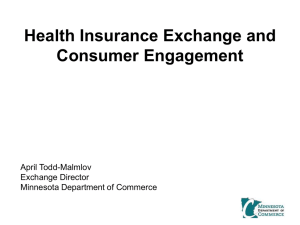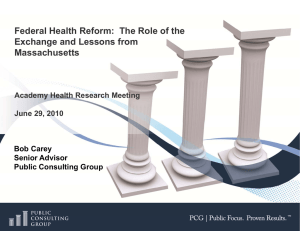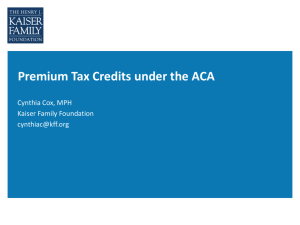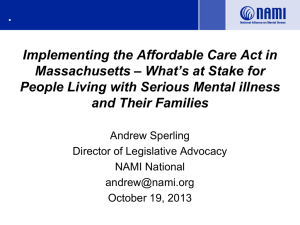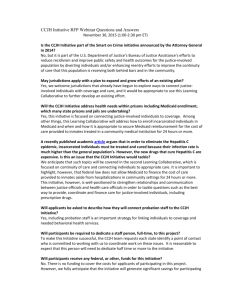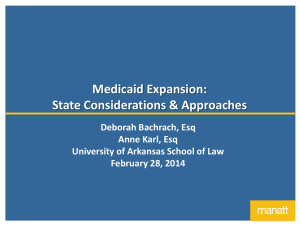Group 1 - Bloomer School District
advertisement
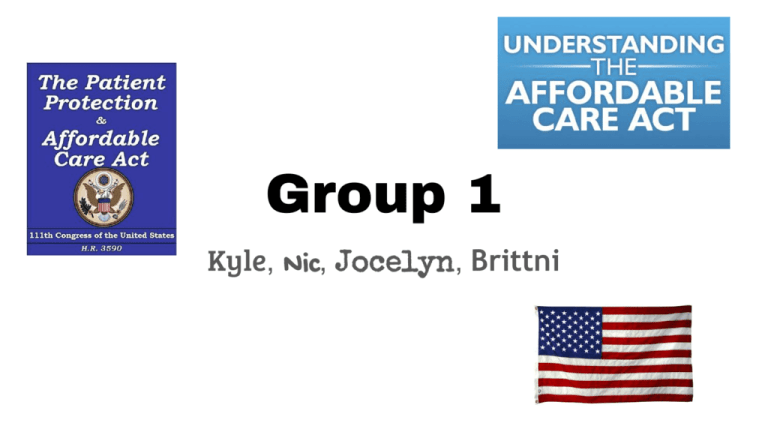
Group 1 Kyle, Nic, Jocelyn, Brittni Overview of the PPACA’s approach to expanding coverage Requires a majority of citizens and residents to have health insurance Violations will induct a tax penalty Creates a system in which to provide cost-sharing credits to individuals and families whose income is between 133-400% of the federal poverty level. Requires employers to pay penalties depending upon whether or not their employees are receiving tax credits for health insurance. Small businesses have exemptions Expands Medicaid to 133% of the federal poverty level. Nic Mattieson Individual Mandate Requires citizens to have health insurance A tax penalty will be implemented on those without qualified coverage. The penalty will be based on a flat fee or percent of taxable income, beginning in 2014. The penalty paid will be the higher of the two, the percentile reaching a maximum of $695. Year Percent of taxable income Flat fee The max penalty of $695 may fluctuate after 2016 due to inflation. 2014 1% $95 2015 2% $325 2016 2.5% $695 Nic Mattieson Exemptions to Mandate Exemptions to the tax will be granted to the following: financial hardship religious objections Native Americans populace that remain uninsured for under three months undocumented immigrants incarcerated individuals those whose income remains under the tax filing threshold for those whom the lowest costing plan costs greater than 8% of their income Nic Mattieson Employer obligations Require employers to offer health insurance Any employer with 50 or more full-time employees, at least one of which receiving a premium tax credit, and does not offer coverage will be fined $2000 per full-time employee (excluding first 30 employees). Any employer with 50 or more full-time employees, at least one of which receiving a premium tax credit, and does offer coverage will be fined the lesser of either: $3000 per employee receiving a premium tax credit $2000 per full-time employee (excluding first 30 employees). Employers with less than 50 full-time employees are exempt from the fines. Mattieson Employers with more than 200 full-time employees must automatically Nic enroll Controversies to the Mandate and Employer Obligations Conflicts with one’s individual liberty May or may not be constitutional Deemed constitutional in 2012 Creates too many expenses for businesses May be detrimental to the job market Nic Mattieson Jocelyn- Treatment of Medicaid Medicaid is helping the poor people afford health-care expands medicaid for anyone under the age of 65 allows states to opt-in or out of the expansion package Jocelyn- Reasons to expand Medicaid Example: Delaware expanded Medicaid Some reasons why a state should expand Medicaid a. It will free up spending that currently went into health care spending b. it could help low profit hospitals keep emergency departments open c. it will reduce the number of uninsured adults within the state d. it will help individuals with mental illness e. it will allow women to get more health benefits Jocelyn-Reasons for no expansion of Medicaid states can say no to the money for expanding medicaid Example: Wisconsin did not Walker calls this a bait and switch which means the federal government baits the state into expanding the program and then switches the funding putting it back on the state. Their will be less doctors because a study in health affairs in 2011 found that ⅓ of doctors would not accept new medicaid patients because medicaid pays the doctors $0.52 per $1 that a private insurer would pay them, so the doctor is losing out $0.48 which would make them not want to be one. Jocelyn-Treatment of Medicaid The government will begin funding which starts out at 100% in 2014 then goes to 95% in 2017, 94% in 2018, 93% in 2019, and 90% in 2020 and this trend will continue to go down in the following decades. This is what Governor Walker meant by baiting and switching, so the federal government gives us funding for more poor people then basically it gives you lower funding for the states over time and they have to somehow have to find a way to pay for this program that is larger than it originally was. Jocelyn-Treatment of CHIP CHIP stand for Children’s Health Insurance Program A state can not change its rules to make less people eligible for the program Eligibility -To be eligible for premiums and cost-sharing subsidies in the Affordable Care Act you must fit the qualifications for many of the government's guidelines. -Some qualifications are being an American citizen, below 65 years of age, and not falling below 133% on the Federal Poverty Level. -Employes who are offered coverage by an employer are not eligible for premium credits unless the employer plan does not have an actuarial value of at least 60% or if the employee share of the premium exceeds 9.5%. Kyle Premium Credits -Premium is what you pay to your insurance company each month. -People who who hover above the poverty line don’t qualify for medicaid but can qualify for premium subsidies. -Premium subsidies is what the government will pay for you so you can buy health insurance. Up to 133% FPL: 2% of income, 133-150% FPL: 3-4% of income 150-200% FPL: 4-6.3% of income, 200-250% FPL: 6.3-8.05% of income, 250-300% FPL: 8.05-9.5% Federal Poverty level chart Kyle Cost-Sharing Subsidies -When you require any medical assistance the insurance company will only pay for so much,deductible, and you have to pay the rest. -People who hover just above the poverty line and need help paying the rest of their bill are eligible for cost-sharing subsidies. -The government will help pay for the rest of your cost. 100-150% FPL: 94%, 150-200% FPL: 87% 200-250% FPL: 73%,250-400% FPL: 70% Kyle Verification -To apply for the Affordable Care Act you need to fill out a lot of paperwork. -You can apply through phone, internet, face to face or by mail. -The government will do a thorough back ground to see if you apply for it and are not cheating the system. -They will look at your tax returns, American citizenship, spouse,age, and where you work. Kyle Subsidies and Abortion Coverage -People can’t use premium subsidies or cost-sharing subsidies for abortions. -Patients can if they were raped or if a pregnant mother is endangered. -You can choose insurance plans that cover abortion, but if you have an abortion you need to pay the full premium amount for that month and all the cost sharing subsidies for the surgery. Kyle Kyle Britt- Small Business Tax Credits ❖ Provides small employers with: ➢ no more than 25 employees ➢ average annual wages of less than $50,000 ➢ health insurance for employees with a tax credit Phase 1: 2010 through 2013 ❖ provide a tax credit up to 35% of the employer’s contribution toward the employee’s health insurance premium ➢ Health insurance premium is the periodic payment made on insurance. ➢ Tax credit is an amount of money that can be offset against a tax liability. ➢ Full credit goes to employers with ■ 10 employees or less ■ average annual wages less than $25,000 ➢ As amount of people increase and wages go up, the credit phases-out, meaning they no longer get full credit Phase 2: 2014 to now ❖ eligible for small business that purchase coverage through the state Exchange ❖ provide a tax credit of up to 50% ❖ credit is available for 2 years ❖ eligible for tax credits of up to 35% ❖ full credit for employers with ➢ 10 or less people ➢ average annual wages less than $25,000 Reinsurance Program ❖ creates a temporary reinsurance program for employers providing health insurance to retirees over the age of 55 and not eligible for Medicare ➢ Medicare is a federal system of health insurance for people over 65 years of age and for certain younger people with disabilities. ❖ reimburses employers for 80% of retirees fees between $15,000 and $90,000 Two Methods of Reinsurance ❖ Facultative Reinsurance ➢ negotiated separately for each insurance policy that is reinsured ➢ normally purchased by companies for individual risks not covered, or insufficiently covered, by their reinsurance treaties ❖ Treaty Reinsurance ➢ the ceding company and the reinsurer negotiate and execute a reinsurance contract which the reinsurer covers the specified share of all the insurance policies issued by the ceding company which come within the scope of that contract ■ Ceding company is an insurance company that passes the part or all of its risks from its insurance policy to a reinsurance firm. Work Cited "Eligibility." Eligibility. Medicaid.gov, n.d. Web. 12 Jan. 2016. "2015 Federal Poverty Level Income Chart." Comrade Financial Group, 23 July 2015. Web. 11 Jan. 2016. Hee Lee, Michelle Ye. "Does Obamacare Provide Federal Subsidies for Elective Abortions?" Washington Post. The Washington Post, 26 Jan. 2015. Web. 12 Jan. 2016. Huston, James. "Help with This Assignment." Bloomer High School, Bloomer. 8 Jan. 2016. Lecture. "Obamacare - Top 20 Views, Obamacare T-shirts - How Does Obamacare Work??" 'Road To Success - Media Watch Dog Anti PEDs and for Honesty in Government' N.p., 22 Oct. 2013. Web. 11 Jan. 2016. "Summary of the Affordable Care Act." The Henry J. Kaiser Family Foundation. Kff.org, 25 Apr. 2013. Web. 07 Jan. 2016. "Why Is Obamacare so Controversial?" BBC News. Bbc.com, n.d. Web. 12 Jan. 2016. www.healthlaw.org/publiccations/50-reasons-medicaid-is-good-for-your-state

